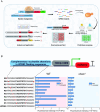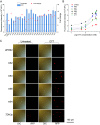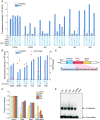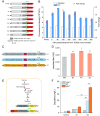Tailored UPRE2 variants for dynamic gene regulation in yeast
- PMID: 38687789
- PMCID: PMC11087760
- DOI: 10.1073/pnas.2315729121
Tailored UPRE2 variants for dynamic gene regulation in yeast
Abstract
Genetic elements are foundational in synthetic biology serving as vital building blocks. They enable programming host cells for efficient production of valuable chemicals and recombinant proteins. The unfolded protein response (UPR) is a stress pathway in which the transcription factor Hac1 interacts with the upstream unfolded protein response element (UPRE) of the promoter to restore endoplasmic reticulum (ER) homeostasis. Here, we created a UPRE2 mutant (UPRE2m) library. Several rounds of screening identified many elements with enhanced responsiveness and a wider dynamic range. The most active element m84 displayed a response activity 3.72 times higher than the native UPRE2. These potent elements are versatile and compatible with various promoters. Overexpression of HAC1 enhanced stress signal transduction, expanding the signal output range of UPRE2m. Through molecular modeling and site-directed mutagenesis, we pinpointed the DNA-binding residue Lys60 in Hac1(Hac1-K60). We also confirmed that UPRE2m exhibited a higher binding affinity to Hac1. This shed light on the mechanism underlying the Hac1-UPRE2m interaction. Importantly, applying UPRE2m for target gene regulation effectively increased both recombinant protein production and natural product synthesis. These genetic elements provide valuable tools for dynamically regulating gene expression in yeast cell factories.
Keywords: Hac1; UPRE2 variants; responsive promoter; unfolded protein response.
Conflict of interest statement
Competing interests statement:C.X., X.L., Y.P., and M.H. applied a patent for protecting UPRE2m development and its application. The remaining authors declare no competing interest.
Figures






Similar articles
-
Autoregulation of the HAC1 gene is required for sustained activation of the yeast unfolded protein response.Genes Cells. 2004 Feb;9(2):95-104. doi: 10.1111/j.1365-2443.2004.00704.x. Genes Cells. 2004. PMID: 15009095
-
The yeast Rab GTPase Ypt1 modulates unfolded protein response dynamics by regulating the stability of HAC1 RNA.PLoS Genet. 2012;8(7):e1002862. doi: 10.1371/journal.pgen.1002862. Epub 2012 Jul 26. PLoS Genet. 2012. PMID: 22844259 Free PMC article.
-
Artificial induction of the UPR by Tet-off system-dependent expression of Hac1 and its application in Saccharomyces cerevisiae cells.Biosci Biotechnol Biochem. 2025 Mar 24;89(4):562-572. doi: 10.1093/bbb/zbaf006. Biosci Biotechnol Biochem. 2025. PMID: 39953902
-
IRE1- and HAC1-independent transcriptional regulation in the unfolded protein response of yeast.Mol Microbiol. 2003 Aug;49(3):591-606. doi: 10.1046/j.1365-2958.2003.03585.x. Mol Microbiol. 2003. PMID: 12864846
-
Translation Control of HAC1 by Regulation of Splicing in Saccharomyces cerevisiae.Int J Mol Sci. 2019 Jun 12;20(12):2860. doi: 10.3390/ijms20122860. Int J Mol Sci. 2019. PMID: 31212749 Free PMC article. Review.
Cited by
-
Promoter engineering with programmable upstream activating sequences in Aspergillus Niger cell factory.Microb Cell Fact. 2025 Jan 15;24(1):20. doi: 10.1186/s12934-025-02642-y. Microb Cell Fact. 2025. PMID: 39815338 Free PMC article.
-
Inheritance of extraordinary metabolic activity from parental bacteria individuals.Proc Natl Acad Sci U S A. 2025 May 13;122(19):e2502818122. doi: 10.1073/pnas.2502818122. Epub 2025 May 9. Proc Natl Acad Sci U S A. 2025. PMID: 40343988
References
-
- Hou J., Tyo K. E., Liu Z., Petranovic D., Nielsen J., Metabolic engineering of recombinant protein secretion by Saccharomyces cerevisiae. FEMS Yeast Res. 12, 491–510 (2012). - PubMed
-
- Idiris A., Tohda H., Kumagai H., Takegawa K., Engineering of protein secretion in yeast: Strategies and impact on protein production. Appl. Microbiol. Biotechnol. 86, 403–417 (2010). - PubMed
-
- Ron D., Walter P., Signal integration in the endoplasmic reticulum unfolded protein response. Nat. Rev. Mol. Cell Biol. 8, 519–529 (2007). - PubMed
Publication types
MeSH terms
Substances
Grants and funding
LinkOut - more resources
Full Text Sources

